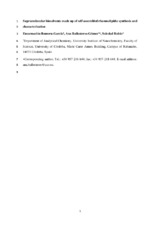Supramolecular biosolvents made up of self-assembled rhamnolipids: synthesis and characterization
Autor
Romera García, Encarnación
Ballesteros-Gómez, A.
Rubio Bravo, Soledad
Editor
Royal Society of ChemistryFecha
2020Materia
Supramolecular solvent (SUPRAS)Biosurfactant
Rhamnolipid
Salt-induced coacervation
Vesicles
Extraction
METS:
Mostrar el registro METSPREMIS:
Mostrar el registro PREMISMetadatos
Mostrar el registro completo del ítemResumen
Simple coacervation of surfactants constitutes a powerful bottom-up strategy for the production of tailored supramolecular solvents (SUPRASs), which feature outstanding properties in extraction processes. In this study, we develop for the first time SUPRASs made up from biosurfactants (produced by microorganisms) as a greener alternative to synthetic surfactants. Rhamnolipds (RLs) were selected for this purpose due to their green properties and their high potential for industrial applicability. BioSUPRASs were spontaneously produced at room temperature from aqueous solutions of rhamnolipids (RLs) by salt-induced coacervation (NaCl, Na2SO4 or NH4CH3CO2). RLs quantitatively incorporated into the bioSUPRAS phase, so that the process had high atom economy. The boundaries for the coacervation region were delimited as a function of RL and salt concentration and equations were derived to predict the volume of bioSUPRAS from the composition of the synthesis mixture. The composition of bioSUPRASs could be tailored by modifying the concentration of the coacervation-inducing salt. BioSUPRAS aggregates were characterized by dynamic light scattering and cryo-scanning electron microscopy and consisted of vesicles in a size range from nm to μm. These aggregates offer a variety of interactions for solute solubilisation (dispersion, ionic, dipole–dipole and hydrogen bonding), different polarity microenvironments (RL head group, RL hydrocarbon chains, vesicle aqueous cavity) and a huge number of binding sites (RL concentration varied from 205 to 444 g L−1). The potential of bioSUPRASs for efficient extraction was illustrated by the recovery of highly polar ionic dyes from water with yields above 94%. The compliance of RL-based bioSUPRASs with the twelve principles of green chemistry is discussed.

